How to Use Tobramycin Inhalation Solution
Learn how to use Teva’s Tobramycin Inhalation
Solution
Tobramycin Inhalation Solution: for the management of cystic fibrosis patients with Pseudomonas aeruginosa
Follow the instructions below for taking Tobramycin Inhalation Solution. If you have any questions, ask your healthcare provider or pharmacist.
Supplies you will need to take Tobramycin Inhalation Solution (See Figure A):
- 1 ampule of Tobramycin Inhalation Solution
- PARI LC PLUS reusable Nebulizer
- PARI Vios compressor
- tubing to connect the nebulizer and compressor
- clean paper or cloth towels
- nose clips (optional)
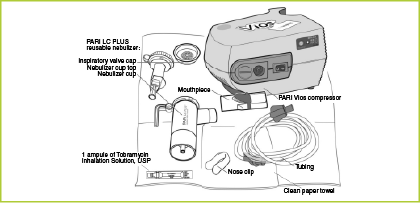
Figure A
Tobramycin inhalation solution is used only in a PARI LC PLUS re-usable Nebulizer connected to a PARI LC PLUS Vios air compressor. Make sure you know how to use your nebulizer machine before you use it to breathe in tobramycin inhalation solution.
Do not mix tobramycin inhalation solution with other medicines in your nebulizer.
Tobramycin inhalation solution comes in a sealed foil pouch. Do not open a sealed pouch until you are ready to use a dose of tobramycin inhalation solution. After opening the pouch, unused ready-to-use ampules should be returned to, and stored in, the pouch.
Getting ready:
- Put your PARI LC PLUS Reusable Nebulizer Top and Bottom (Nebulizer Cup) Assembly, Inspiratory Valve Cap, Mouthpiece with Valve, and Tubing on a clean and dry surface.
- Wash your hands with soap and water.
Preparing your Tobramycin Inhalation Solution dose
1
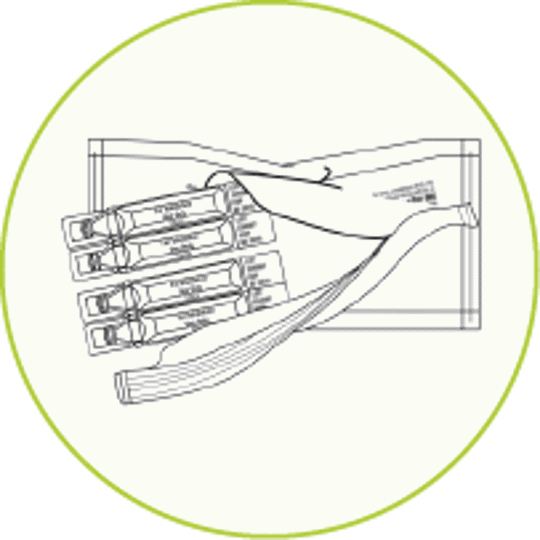
1. Open foil pouch

2
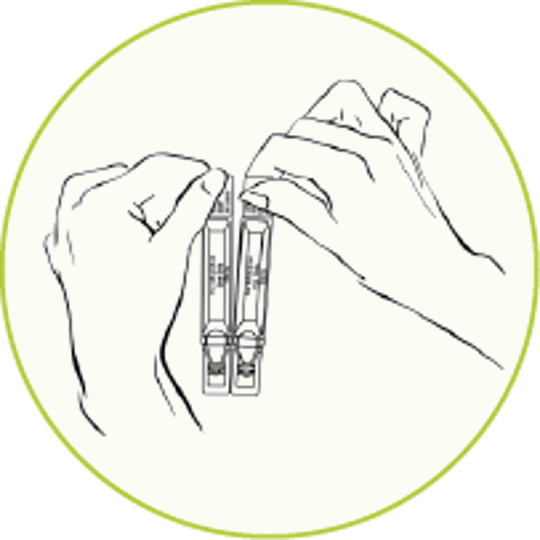
2. Separate 1 ampule by gently pulling apart at the bottom tabs and use it right away.
3
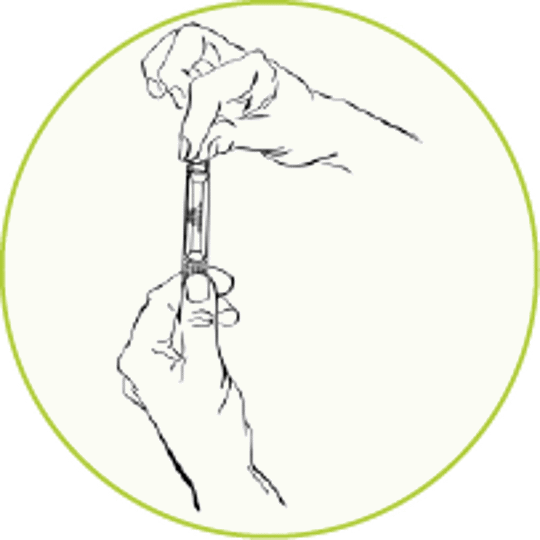
3. Hold the bottom tab on the Tobramycin Inhalation Solution ampule with 1 hand. With your other hand, hold the top of the ampule and twist off the top of the ampule.
Do not squeeze the ampule until you are ready to squeeze all the medicine into the Nebulizer Cup.
4
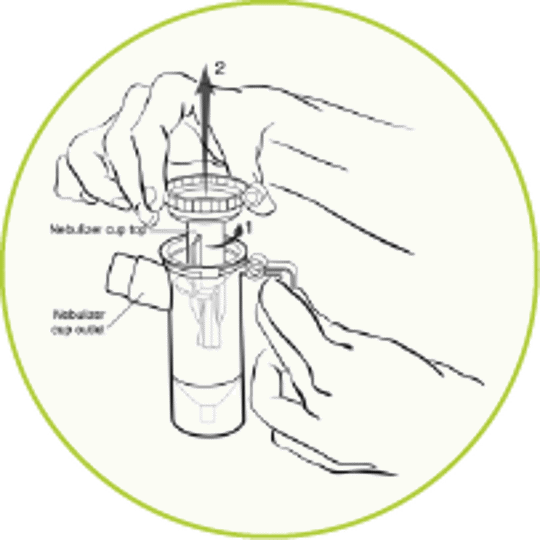
4. Hold the Nebulizer Cup and twist off the Nebulizer Cup Top in a counter-clockwise direction. Set the Top aside on a clean, dry surface.
5
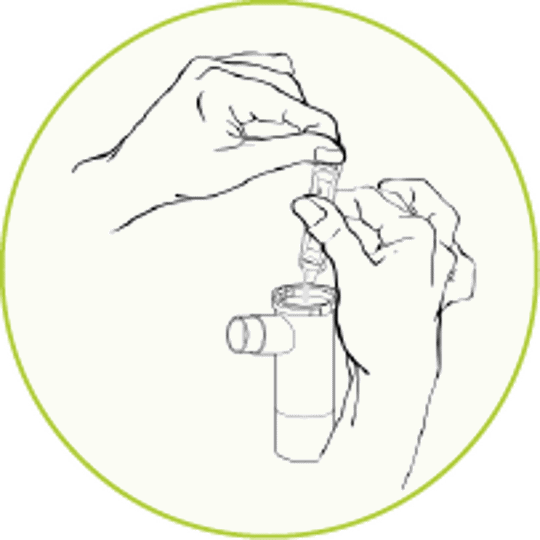
5. Squeeze all of the medicine from the ampule into the Nebulizer Cup.
6
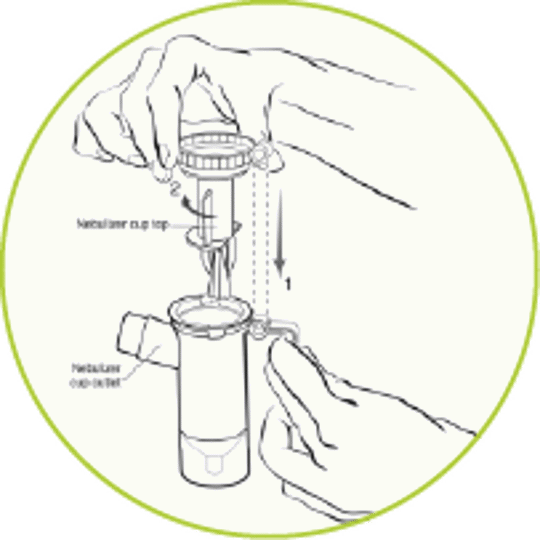
6. Line up the semi-circle on the Nebulizer Cup Top with the Nebulizer Cup Outlet and twist on the Nebulizer Cup Top in a clock-wise direction until it is tight.
7
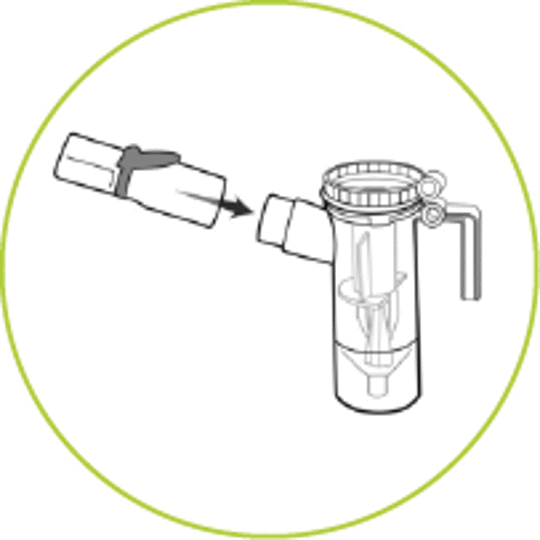
7. Push the mouthpiece straight onto the Nebulizer Cup Outlet.
8
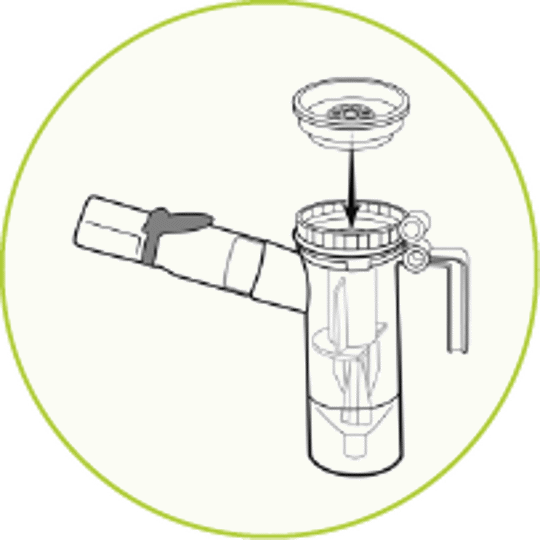
8. Firmly push the Inspiratory Valve Cap straight down onto the Nebulizer Cup Top. The Inspiratory Valve Cap should fit tightly.
9
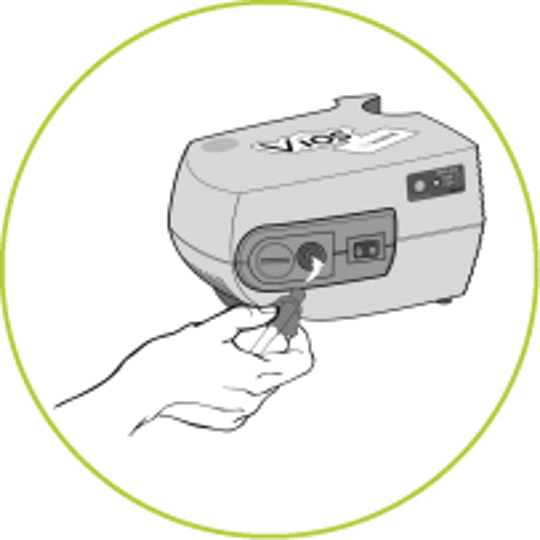
9. Connect 1 end of the tubing to the compressor air outlet. The tubing should fit tightly.
10
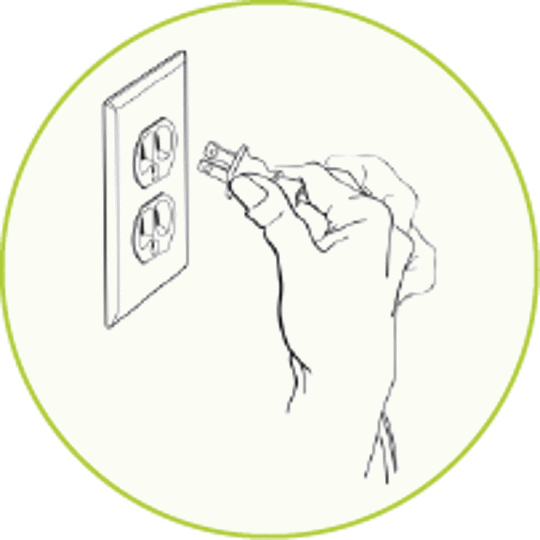
10. Plug your compressor plug into an electrical outlet.
11
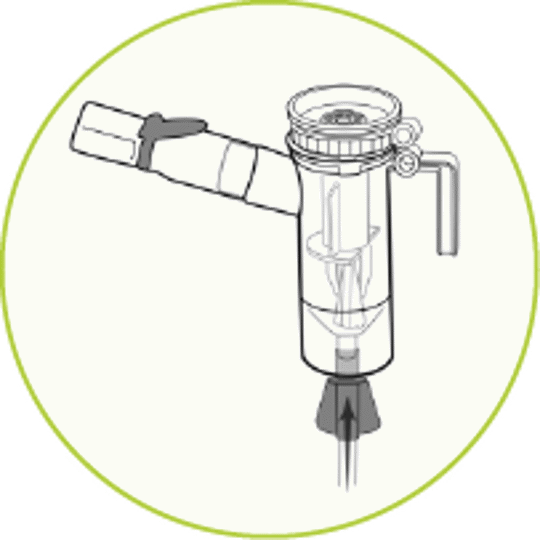
11. Hold the Nebulizer Cup upright and firmly push the free end of the tubing straight up onto the Air Intake on the bottom of the Nebulizer Cup.
Make sure to keep the Nebulizer Cup upright.
Giving your Tobramycin Inhalation Solution dose
12
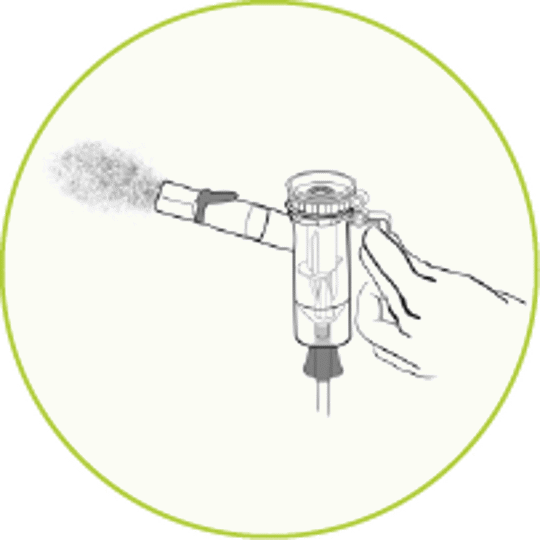
12. Turn on the compressor and check the Mouthpiece. You should see a steady mist coming from the Mouthpiece.
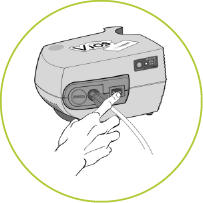
If you do not see a steady mist coming from the mouthpiece, check all tubing connections and make sure that the compressor is working the right way.
13
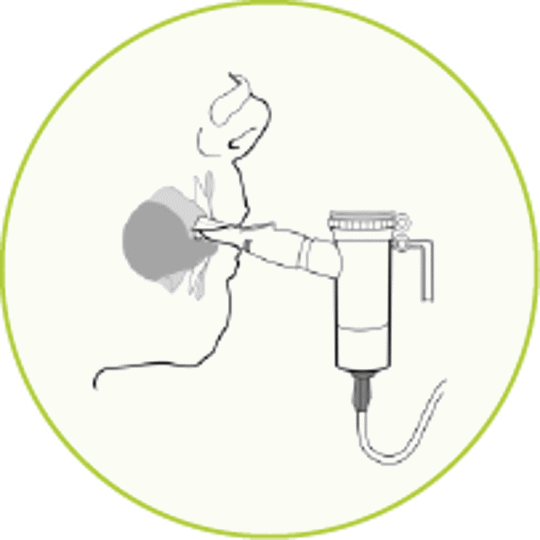
13. Sit or stand in a comfortable, upright position that will let you breathe normally. Place the Mouthpiece between your teeth and on top of your tongue and breathe normally only through your mouth.
Nose clips may help you breathe only through your mouth and not through your nose.
14. Keep breathing in your Tobramycin Inhalation Solution dose for at least 15 minutes. You will know that you have received your full dose of medicine when you hear a “spitting noise” coming from the Mouthpiece for at least 1 minute and the Nebulizer Cup is empty.
15. After your Tobramycin Inhalation Solution dose, clean and disinfect your nebulizer (see manufacturer’s instructions).
Care and Use of Your PARI Vios® Compressor
Follow the manufacturer’s instructions for care and use of your compressor.
IMPORTANT SAFETY INFORMATION
Do not take tobramycin inhalation solution if you are allergic to tobramycin, any of the ingredients in tobramycin inhalation solution, or to any other aminoglycoside antibacterial.
See the end of the Patient Information Leaflet found in the Prescribing Information for a complete list of ingredients in tobramycin inhalation solution.
Before you take tobramycin inhalation solution, tell your healthcare provider about all of your medical conditions, including if you:
- have or have had hearing problems (including noises in your ears such as ringing or hissing) hearing loss, or your mother has had hearing problems after taking an aminoglycoside.
- have been told you have certain gene variants (a change in the gene) related to hearing abnormalities inherited from your mother.
- have dizziness
- have or have had kidney problems
- have or have had problems with muscle weakness such as myasthenia gravis or Parkinson’s disease
- have or have had breathing problems such as wheezing, coughing, or chest tightness
- are pregnant or plan to become pregnant. Tobramycin inhalation solution is in a class of medicines that can harm your unborn baby and may be connected with complete deafness in babies at birth. The deafness affects both ears and cannot be changed.
- are breastfeeding or plan to breastfeed. It is not known if tobramycin passes into your breast milk. Tobramycin, the medicine in tobramycin inhalation solution may cause the following symptoms in your breastfed baby:
- loose or bloody stools
- yeast infection in the mouth or throat (thrush)
- diaper rash
Call your baby’s healthcare provider if your breastfed baby has any of these problems. Talk to your healthcare provider about the best way to feed your baby during treatment with tobramycin inhalation solution.
- are receiving aminoglycoside therapy by injection or through a vein (intravenous) while taking tobramycin inhalation solution. Your blood levels of tobramycin will be checked.
Tell your healthcare provider about all the medicines you take, including prescription medicines, over-the-counter medicines, vitamins, and herbal supplements.
What are the possible side effects of tobramycin inhalation solution?
Tobramycin inhalation solution can cause serious side effects, including:
- hearing loss or ringing in the ears (ototoxicity). Some people who were treated with tobramycin, the medicine in tobramycin inhalation solution had hearing loss or ringing in the ears. Tell your healthcare provider right away if you have hearing loss or hear noises in your ears (such as ringing or hissing), or if you develop vertigo, dizziness, or difficulty with balance.
- worsening kidney problems (nephrotoxicity). Your healthcare provider may do a blood test and urine test to check how your kidneys are working while you are taking tobramycin inhalation solution.
- worsening muscle weakness (neuromuscular disorder). Tobramycin inhalation solution can cause muscle weakness to get worse in people who already have problems with muscle weakness (myasthenia gravis or Parkinson’s disease).
- severe breathing problems (bronchospasm). Tell your healthcare provider right away if you get any of these symptoms of bronchospasm while taking tobramycin inhalation solution:
-
- shortness of breath with wheezing
- coughing and chest tightness
The most common side effects of tobramycin inhalation solution include:
- worsening of lung problems or cystic fibrosis
- noisy breathing (rales)
- abnormal red blood cell activity
- changes in your voice (hoarseness)
These are not all of the possible side effects of tobramycin inhalation solution.
Call your doctor for medical advice about side effects. You are encouraged to report side effects of prescription drugs to the FDA. Visit www.fda.gov/medwatch or call 1-800-FDA-1088.
Please read the Patient Leaflet in the full Prescribing Information.
What is tobramycin inhalation solution?
Tobramycin inhalation solution is a prescription medicine that is used to treat people with cystic fibrosis who have a bacterial infection called Pseudomonas aeruginosa. Tobramycin inhalation solution contains an antibacterial medicine called tobramycin (an aminoglycoside).
It is not known if tobramycin inhalation solution is safe and effective:
- in children under 6 years of age
- in people who have decreased lung volume or a forced expiratory volume in one second (FEV1) less than 40% or greater than 80% predicted
- in people who are colonized with a bacterium called Burkholderia cepacia